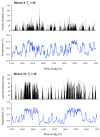Episodic Ultradian Events-Ultradian Rhythms
- PMID: 30875767
- PMCID: PMC6466064
- DOI: 10.3390/biology8010015
Episodic Ultradian Events-Ultradian Rhythms
Abstract
In the fast lane of chronobiology, ultradian events are short-term rhythms that have been observed since the beginning of modern biology and were quantified about a century ago. They are ubiquitous in all biological systems and found in all organisms, from unicellular organisms to mammals, and from single cells to complex biological functions in multicellular animals. Since these events are aperiodic and last for a few minutes to a few hours, they are better classified as episodic ultradian events (EUEs). Their origin is unclear. However, they could have a molecular basis and could be controlled by hormonal inputs-in vertebrates, they originate from the activity of the central nervous system. EUEs are receiving increasing attention but their aperiodic nature requires specific sampling and analytic tools. While longer scale rhythms are adaptations to predictable changes in the environment, in theory, EUEs could contribute to adaptation by preparing organisms and biological functions for unpredictability.
Keywords: central nervous system; gene; methodology; short-term rhythms; temperature.
Conflict of interest statement
The authors declare no conflict of interest.
Figures





References
-
- Aschoff J. Biological Rhythms. Plenum Press; New York, NY, USA: 1981. p. 563.
-
- Szymanski J.S. Aktivität und ruhe bei tieren und menschen. Z. Fjur. Allg. Physiol. 1920;18:105–162.
-
- Daan S., Aschoff J. Short-term rhythms in activity. In: Aschoff J., editor. Biological Rhythms. Plenum Press; New York, NY, USA: 1981. pp. 491–498.
-
- Acharya U.R., Hagiwara Y., Deshpande S.N., Suren S., Koh J.E.W., Oh S.L., Arunkumar N., Ciaccio E.J., Lim C.M. Characterization of focal EEG signals: A review. Future Gener. Comput. Syst. 2019;91:290–299. doi: 10.1016/j.future.2018.08.044. - DOI
Publication types
LinkOut - more resources
Full Text Sources

